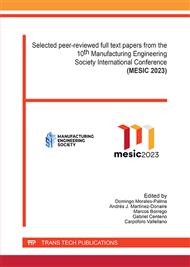[1]
V. Alcácer, V. Cruz-Machado, Scanning the Industry 4.0: A Literature Review on Technologies for Manufacturing Systems. Engineering Science and Technology, an International Journal. 22 (2019), 899–919.
DOI: 10.1016/j.jestch.2019.01.006
Google Scholar
[2]
J.A. Saucedo-Martínez, M. Pérez-Lara, J.A. Marmolejo-Saucedo, T.E. Salais-Fierro, P. Vasant, Industry 4.0 Framework for Management and Operations: A Review. J Ambient Intell Human Comput 9 (2018) 789–801.
DOI: 10.1007/s12652-017-0533-1
Google Scholar
[3]
M. Peruzzini, F. Grandi, M. Pellicciari, Benchmarking of Tools for User Experience Analysis in Industry 4.0, Procedia Manufacturing. 11 (2017) 806-813.
DOI: 10.1016/j.promfg.2017.07.182
Google Scholar
[4]
J. Lee, B. Bagheri, H.A. Kao, A Cyber-Physical Systems Architecture for Industry 4.0-Based Manufacturing Systems. 3 (2015) 18-23.
DOI: 10.1016/j.mfglet.2014.12.001
Google Scholar
[5]
M. Grieves, Virtually Intelligent Product Systems: Digital and Physical Twins, in: S. Flumerfelt, K.G. Schwartz, D. Mavis, S. Briceno (Eds.), Complex Systems Engineering: Theory and Practice, American Institute of Aeronautics and Astronautics, 2019, pp.175-200.
DOI: 10.2514/5.9781624105654.0175.0200
Google Scholar
[6]
W. de Paula Ferreira, F. Armellini, L.A. De Santa-Eulalia, Simulation in Industry 4.0: A State-of-the-Art Review, Computers and Industrial Engineering. 149 (2020) 106868.
DOI: 10.1016/j.cie.2020.106868
Google Scholar
[7]
C.J. Turner, W. Garn, Next Generation DES Simulation: A Research Agenda for Human Centric Manufacturing Systems, Journal of Industrial Information Integration. 28 (2022) 100354.
DOI: 10.1016/j.jii.2022.100354
Google Scholar
[8]
G. Dagkakis, C. Heavey, A Review of Open Source Discrete Event Simulation Software for Operations Research. Journal of Simulation. 10 (2016) 193–206.
DOI: 10.1057/jos.2015.9
Google Scholar
[9]
S. Lang, T. Reggelin, M. Müller, A. Nahhas, Open-Source Discrete-Events Simulation Software for Application in Production and Logistics: An Alternative to Commercial Tools?, Proceedings of the Procedia Computer Science. 180 (2021) 978–987.
DOI: 10.1016/j.procs.2021.01.349
Google Scholar
[10]
N. Boysen, M. Fliedner, A. Scholl, A classification of assembly line balancing problems, European journal of Operational Research. 183 (2007) 674-693.
DOI: 10.1016/j.ejor.2006.10.010
Google Scholar
[11]
F. Mas, J. L. Menéndez, M. Oliva, J. Ríos, A. Gómez and V. Olmos, iDMU as the Collaborative Engineering engine: Research experiences in Airbus, International Conference on Engineering, Technology and Innovation (ICE). 1 (2014) 1-7.
DOI: 10.1109/ice.2014.6871594
Google Scholar
[12]
F. Mas, J. Ríos, A. Gómez, J. C. Hernández, Knowledge-based application to define aircraft final assembly lines at the industrialisation conceptual design phase, International Journal of Computer Integrated Manufacturing, 29 (2016) 677-691.
DOI: 10.1080/0951192x.2015.1068453
Google Scholar
[13]
J. Ríos, F. Mas, J.L. Menéndez, Aircraft Final Assembly Line Balancing and Workload Smoothing: A Methodological Analysis, Key Engineering Materials. 502 (2012) 19–24.
DOI: 10.4028/www.scientific.net/kem.502.19
Google Scholar
[14]
T. Borreguero, F. Mas, J.L. Menéndez, M.A. Barreda, Enhanced Assembly Line Balancing and Scheduling Methodology for the Aeronautical Industry, Procedia Engineering. 132 (2015) 990-997.
DOI: 10.1016/j.proeng.2015.12.587
Google Scholar
[15]
Ríos, José, Fernando Mas, Manuel Oliva, and Juan Carlos Hernández. 2016. "Framework to Support the Aircraft Digital Counterpart Concept with an Industrial Design View." International Journal of Agile Systems and Management 9 (3): 212–31.
DOI: 10.1504/ijasm.2016.079934
Google Scholar
[16]
J. Autiosalo, J. Vepsalainen, R. Viitala, K.A. Tammi, Feature-Based Framework for Structuring Industrial Digital Twins, IEEE Access. 8 (2020) 1193–1208.
DOI: 10.1109/access.2019.2950507
Google Scholar
[17]
J. Vachalek, L. Bartalsky, O. Rovny, D. Sismisova, M. Morhac, M. Loksik, The Digital Twin of an Industrial Production Line within the Industry 4.0 Concept, Proceedings of the 2017 21st International Conference on Process Control (PC). 1 (2017) 258–262.
DOI: 10.1109/pc.2017.7976223
Google Scholar
[18]
J. Trauer, S. Schweigert-Recksiek, C. Engel, K. Spreitzer, M. Zimmermann, What is a digital twin? – definitions and insights from an industrial case study in technical product development. Proc. Des. Soc Des. Conf. 1, (2020) 757–766.
DOI: 10.1017/dsd.2020.15
Google Scholar
[19]
E. Flores-García, G.Y. Kim, J. Yang, M. Wiktorsson, S. Do Noh, Analyzing the Characteristics of Digital Twin and Discrete Event Simulation in Cyber Physical Systems. In Advances in Production Management Systems. Towards Smart and Digital Manufacturing, B. Lalic, V. Majstorovic, U. Marjanovic, G. von Cieminski, D. Romero (Eds), Springer International Publishing, Cham, 2020, p.238–244.
DOI: 10.1007/978-3-030-57997-5_28
Google Scholar
[20]
J.G Campos, J.S. López, J.I Armesto, A.M. Espada, Automatic Generation of Digital Twin Industrial System from a High Level Specification, Procedia Manufacturing. 38 (2019) 1095–1102.
DOI: 10.1016/j.promfg.2020.01.197
Google Scholar
[21]
A.F. Mendi, A Digital Twin Case Study on Automotive Production Line, Sensors. 22 (2022) 6963.
DOI: 10.3390/s22186963
Google Scholar
[22]
R. Rosen, G. von Wichert, G. Lo, K.D. Bettenhausen, About The Importance of Autonomy and Digital Twins for the Future of Manufacturing, IFAC-PapersOnLine. 48 (2015) 567–572.
DOI: 10.1016/j.ifacol.2015.06.141
Google Scholar
[23]
J. O'Sullivan, D. O'Sullivan, K.A. Bruton, A Case-Study in the Introduction of a Digital Twin in a Large-Scale Smart Manufacturing Facility, Procedia Manufacturing. 51 (2020) 1523–1530.
DOI: 10.1016/j.promfg.2020.10.212
Google Scholar
[24]
R.B. Roy, D. Mishra, S.K. Pal, T. Chakravarty, S. Panda, M.G. Chandra, A. Pal, P. Misra, D. Chakravarty, S. Misra, Digital Twin: Current Scenario and a Case Study on a Manufacturing Process, Int J Adv Manuf Technol. 107 (2020) 3691–3714.
DOI: 10.1007/s00170-020-05306-w
Google Scholar
[25]
Y. He, J. Guo, X. Zheng, From Surveillance to Digital Twin: Challenges and Recent Advances of Signal Processing for Industrial Internet of Things IEEE Signal Process. Mag. 35 (2018) 120–129.
DOI: 10.1109/msp.2018.2842228
Google Scholar
[26]
A. Nait-Sidi-Moh, A. El-Amraoui, Modeling and Optimization of Cyclic Hoist Schedules in an Electroplating Line, J. Syst. Sci. Syst. Eng. 25 (2016) 469–490.
DOI: 10.1007/s11518-015-5294-9
Google Scholar
[27]
J. Feng, C. Chu, A. Che, Cyclic Jobshop Hoist Scheduling with Multi-Capacity Reentrant Tanks and Time-Window Constraints, Computers & Industrial Engineering. 120 (2018) 382–391.
DOI: 10.1016/j.cie.2018.04.046
Google Scholar
[28]
K. Verma, H. Cao, P. Mandapalli, R. Wille, Modeling and Simulation of Electrophoretic Deposition Coatings, Journal of Computational Science. 41 (2020) 101075.
DOI: 10.1016/j.jocs.2020.101075
Google Scholar
[29]
S. Robinson, Conceptual Modelling for Simulation. Part II: A Framework for Conceptual Modelling, Journal of the Operational Research Society. 59 (2008) 291–304.
DOI: 10.1057/palgrave.jors.2602369
Google Scholar
[30]
JaamSim Development Team (2016). JaamSim: Discrete-Event Simulation Software. Version 2016-14.
Google Scholar
[31]
J. Feng, A. Che, C. Chu, Dynamic Hoist Scheduling Problem with Multi-Capacity Reentrant Machines: A Mixed Integer Programming Approach, Computers & Industrial Engineering. 87 (2015) 611–620.
DOI: 10.1016/j.cie.2015.06.004
Google Scholar



